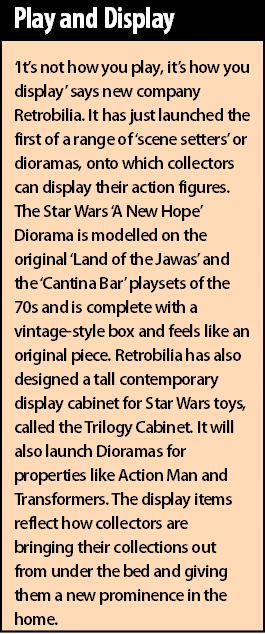Insight - Toys for big boys
]> Toys are no longer just for children. As adults buy into the collectible and 'urban vinyl' markets, how big an opportunity is this for licensing? Tom Conway reports.
April 6, 2018

]>
Toys are no longer just for children. As adults buy into the collectible and 'urban vinyl' markets, how big an opportunity is this for licensing? Tom Conway reports.

It's official; toys are no longer child's play. Twenty years ago adults had to content themselves with hard work, bills and beer, leaving frivolous indulgences such as toys, cartoons and comics to the children. These days, however, action figures called things like 'Scary Girl' and 'Spiderman Kubrick' are as likely to grace the Christmas list of a 30 year-old businessman as that of an 8 year-old boy. Adults have become fascinated with these totems of childhood, and toys have even become, whisper it, cool.
The statistics show that adults have become more frequent buyers of action figures. In 2003 overall sales of figures and accessories hit $1.2bn in the US, according to NPD Group. And their surveys show that 20% of customers are 18 and above, buying for themselves, not for their children. 
There has certainly been a shift in the way toys are perceived. Barry Eldridge, who works for online collectible retailer R2Dtoys says, 'ten years ago, collecting toys was considered juvenile or a bit anorak-y. Now popular culture has changed and young adults see nothing wrong with collecting toys and playing computer games.'
So what sort of toys are these big kids buying? Much of it is what can be termed memorabilia, encompassing science fiction, fantasy, horror and cult film and TV merchandising. The retailer at the forefront of selling this sort of merchandise in the UK is Forbidden Planet, through its high-street and online shops and by mail order. Andy Oddie, who runs Forbidden Planet, says, 'most of the toy merchandise is movie-driven. A movie with some sort of cult aspect is likely to do well. Recently Napoleon Dynamite and Kevin Smith merchandise have been doing really well, as well as Sin City, Fantastic Four and Star Wars.'
Above all, the main driver of sales will always be the content of the original property: 'People want to own a piece of their favourite movie or book. Without a great story, people won't buy the toy,' says Andy. 'The toys for the first Matrix film, for example, were of poor quality, but they sold by the bucket load because the film itself had such a cult following.' 
He identifies two factors that have contributed significantly over recent years to the increasing popularity of toys among adults. The first is that new moulding technology has made small-run toys cheap to make. 'Roto-cast and new scanning technology has enabled accurate figurines to be produced of better quality, and they can be produced profitably in small numbers.' Quality is important, and many collectors will stick with a specific manufacturer because they like the style and quality of the finish. 'McFarlane Toys, for example, have a great reputation and people buy because they are sure what they are getting is quality.'
The second factor is the internet, specifically eBay. 'Internet auction sites like eBay have been a big driver. It means buyers can look at everything that's on offer, look at pictures, and buy from anywhere in the world. Most of Forbidden Planet's business is now online.'
Barry Eldridge of R2Dtoys agrees. 'The internet has meant that buyers no longer need to find specialist stores. It has also had a major impact from a collectible point of view. A run of 10,000 becomes much more collectible spread over the whole world, whereas previously toys would be tied to one geographical market. It also acts like a stock market; you can guage the value of a toy by assessing demand on eBay.' 

After a quick search on eBay we found a Darth Vader Kubrick figure (6cm tall), made by Medicom Toys and going for $328.99. The major factor in its value was its rarity. The description included the following: 'Japan exclusive toy made for Japanese markets only. It is only produced in SUPER limited quantities...'
So to what extent does rarity, or the perception of scarcity, fuel the toy market? According to Andy Oddie, it is not as important as it used to be. 'Limited edition doesn't mean anything unless it says how much it is limited to.' Barry Eldridge concurs, 'people are suspicious of anything that is limited edition. Those customers looking for something rare tend to wait to see if it is a legitimate collectible by looking at demand online.'
It's not easy to predict what will be popular amongs the adult generation; there's no accounting for taste. 'It's all down to emotion' says Barry Eldridge. 'It's hard to say which toy people will like and what they won't. People buy toys for the love of the object. It's irrational. It is just stuff, it has no real function, and for that reason it is hard to forecast.' 
This fickleness and general mysteriousness has arguably meant that major retailers have shied away from the market, unsure of how to turn it into a commercial enterprise because they usually need to plan so far in advance. Andy Oddie believes that Forbidden Planet has no real direct competitors. 'The UK is well behind the US in understanding the adult collectibles market. In the US retailers like Toys R Us, Hot Topic and Spencer Toys have specialty toy sections, in which customers can find retailer exclusives.' It was clear, when visiting in June, that FAO Schwartz had transformed the basement of its New York store into a destination for grown-up toy fans. Star Wars models with signed certificates from Howard Roffman (president, Lucas Licensing) were on display with rare action figures from other, less well known movies.
In the UK, however, retailers have yet to capitalise on growing demand. 'Some major retailers compete with Star Wars and Lord of the Rings, but generally I think it is a market that buyers in big companies struggle to understand. It requires very specialist knowledge to understand what will be a successful, and what won't,' says Andy. For this reason Forbidden Planet employs what Andy calls 'fanboys'; people who are part of the culture themselves and understand what customers want.
Barry highlights another trend that will impact the market later on. In much the same way that Bratz dolls have rejuvenated the fashion doll market for older girls, so films like Lord of the Rings have reminded older boys that it's OK to have toys, even if you just want to own them rather than play with them. 

Urban Vinyl
Distinct from the memorabilia and movie action figure market, but simlar in other ways is the market for designer toys or 'Urban Vinyl'. It's a market Andy Oddie calls a 'toy sub-culture', and it attracts a totally different audience that is more pop, ironic and design-conscious. Creators of these toys are still attracted to licensed properties but often use them as part of the design rather than make slavish replicas. It's a trend underpinned by the defacement and undermining of pop-culture. New York-based artist Kaws, for example, creates distorted Mickey Mouse and Michelin Man figures.
The phenomenon of designer toys for adults first took Asia by storm in the late 1990's. Vinyl toys created by artists, graffiti artists, designers and illustrators transcended the category of 'toy' to become collectable art pieces in their own right. They were popularized by shops like Bounty Hunter, a cult boutique that sold limited edition urban-clothing. The designers behind the boutique started selling limited edition toys, which proved popular with Tokyo's trendy twentysomethings.
Subsequently, designers like Micheal Lau became highly influential. Lau started making distorted GI Joes but it was his skate-influenced fashion figures called Gardeners that made him an icon and brought the toys to a wider audience. For example, Nike Japan featured him in a series of Presto shoe adverts and Levi Strauss used him to promote their Engineered Jeans. Since 1999, Sony Music Entertainment Television has owned the Japanese license to the Gardner series, putting them on keyrings, t-shirts and Visa cards.
Now the trend for toys has spread to the West thanks to the internet and to fans, such as clothing brand Maharishi, which was one of the first to introduce Kubrick figures. Kubrick figures, made by Japanese company Medicom Toys, are about 6-8cm tall, rigidly stylized and come in three kinds; limited, regular and set. Medicom makes its own distinctive versions of licensed characters from the likes of Disney and Marvel as well as many, less obvious licenses. It has worked with Nike and French designer store Colette, for example, on special toys.
Aidan Onn, proprietor of designer toy shop Playlounge based in London, grew up in Hong Kong where he developed an interest in designer toys. 'The rapid development of internet communication has brought things to the West,' he says. 'Adult-orientated toy culture, rooted in Manga and Anime, has long been an Asian preserve, and the net has given the world access to it.'
The toys in Playlounge are mainly design-orientated, blurring the line between art and toy. 'We try to avoid the action and fantasy genre, because there is so much more interesting stuff around.' Playlounge stocks things like Ugly Dolls, the Reebok Zombies, Monsterisms, Kubrick figures, Cubees and King Ken. What is so appealing about these objects to collectors? 'Mostly it's the quality and aesthetic of the object, but there is also a scarcity aspect. People like to own something rare and unique.' Among the most popular toys of the moment in Playlounge are a series by James Jarvis with a very distinctive style, and they are most definitely 'cool'; London rap collective The Mitchell Brothers recently featured his Young Ruffian and Policemen figures in a music video.
Aidan sees designer toys as a growing market, 'It hasn't really kicked off in the UK yet like it has in America, but I like to think Playlounge is pushing things forward. I believe toys will evolve and become part of the mainstream as design objects rather than toys.'
As the market grows and more people are seduced by the idea of these toys for display not play, there is likely to be more opportunity for licensing. Kidrobot, a large chain of designer toy stores on the West Coast of the US, now produce toys under license. A recent example is a line of vinyl figures depicting the band Gorillaz, based on Jamie Hewlett's original designs.
Adult-orientated collectables, whether action figure replicas or design-led pieces are toys made to be seen, not smashed. The market might be in its early days right now, but in a retail climate that is forcing licensors to be more resourceful about finding new customers and retail channels, it seems churlish to ignore it.
You May Also Like






